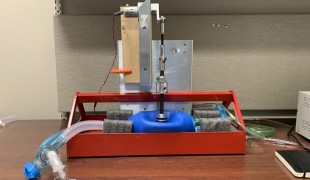- 4840
- 306
- 6
- 4
- 0
- Help Ukraine
About the solution
A volunteer team called MIT E-Vent, composed of engineers, physicians, computer scientists and others, is working to develop a safe and inexpensive alternative to ventilators, for emergency use.
About a decade ago, some students from the Medical Device Design class, working in consultation with local physicians designed a simple ventilator with a budget of about $100. The device design and testing were detailed in a paper but never brought forward until now.
The crucial element for an inexpensive ventilator is a hand-operated plastic pouch called a bag-valve resuscitator, or Ambu bag. What the earlier MIT class did, and the current team is refining, was to devise a mechanical system to do squeeze and release the Ambu bag that provides breaths to a patient. Such a system needs to not damage the bag and has to be controllable, to tailor the amount of air and pressures to be delivered to the particular patient.
To avoid mistakes in the reproduction of such a system, due to lack of the necessary clinical knowledge or expertise with hardware, the team had added to their website verified information resources on the clinical use of the ventilators and the requirements for training and monitoring in using such systems (https://e-vent.mit.edu/).
“We are releasing design guidance (clinical, mechanical, electrical/controls, testing) on a rolling basis as it is developed and documented,” one team member says. “We encourage capable clinical-engineering teams to work with their local resources, while following the main specs and safety information, and we welcome any input other teams may have.”
“At present, we are awaiting FDA feedback” about the project. “Ultimately, our intent is to seek FDA approval. That process takes time, however.”
“The primary consideration is patient safety. So we had to establish what we’re calling minimum clinical functional requirements,” being, the minimum set of functions that the device would need to perform to be both safe and useful.
In a week the team conducted the first realistic tests of a prototype. The cross-disciplinarity nature of the group was crucial. “The most exciting times and when the team is really moving fast are when we have a design engineer, sitting next to a controls engineer, sitting next to the fabrication expert, with an anesthesiologist on WebEx, all solid modeling, coding, and spreadsheeting in parallel. We are discussing the details of everything from ways to track patients’ vital signs data to the best sources for small electric motors,” a team member said.
Adapted from: http://news.mit.edu/2020/ventilator-covid-deployment-open-source-low-cos...
For more information: https://e-vent.mit.edu/
For the study: https://e-vent.mit.edu/wp-content/uploads/2020/03/DMD-2010-MIT-E-Vent.pdf
这些解决方案不应包括使用药物,化学品或生物制品(包括食品);创伤性设备;冒犯性的,商业或内在危险的内容。该解决方案未经医学验证。请谨慎进行!如果您有任何疑问,请咨询健康专家。
DISCLAIMER: This story was written by someone who is not the author of the solution, therefore please be advised that, although it was written with the utmost respect for the innovation and the innovator, there can be some incorrect statements. If you find any errors please contact the patient Innovation team via info@patient-innovation.com
-
-
521
-
1
-
13860

Portuguese student responds to pandemic crisis with open source ventilators
VENTILATION
CAREGIVING
Covid19
3d Printed
Treatment/Surgical device
Sore throat
Fever
Fatigue
Difficulty breathing deeply
Nasal congestion
Dry cough
Sinus pain or pressure.
Shortness of breath
Improving respiratory function
To improve Treatment/Therapy
Raise awareness
General and Family Medicine
Infectious Diseases
Intensive Care Medicine
Pneumology
Portugal
-
-
-
234
-
1
-
4446

Multi patient-one ventilator setup
VENTILATION
Covid19
3d Printed
Treatment/Surgical device
Chest pain or discomfort
Sore throat
Fever
Fatigue
Difficulty breathing deeply
Nasal congestion
Dry cough
Sinus pain or pressure.
Shortness of breath
Improving respiratory function
To improve Treatment/Therapy
General and Family Medicine
Infectious Diseases
Intensive Care Medicine
Pneumology
Belgium
-
-
-
181
-
0
-
3915

Team develops 150$ ventilator that is the size of a cereal box
VENTILATION
Social interaction
Covid19
Treatment/Surgical device
Sore throat
Fever
Fatigue
Difficulty breathing deeply
Nasal congestion
Dry cough
Sinus pain or pressure.
Shortness of breath
Improving respiratory function
To improve Treatment/Therapy
Preventing (Vaccination, Protection, Falls, Research/Mapping)
Caregiving Support
General and Family Medicine
Infectious Diseases
Intensive Care Medicine
Pneumology
United States
-
 zh
zh